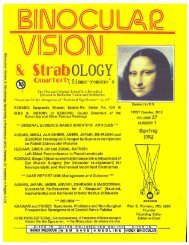Correspondence - ICO Library
Correspondence - ICO Library
Correspondence - ICO Library
You also want an ePaper? Increase the reach of your titles
YUMPU automatically turns print PDFs into web optimized ePapers that Google loves.
-44-<br />
Binocular Vision & Diagnosis and Surgical Treatm ent of Dissociated Horizontal Deviation Strabism us FIRST Quarter of 2011<br />
Strabology Quarterly© S. Gam io, M D Volum e 26 (No.1)<br />
A M edical Scientific e-Periodical Pages 43-50<br />
INTRODUCTION<br />
Dissociated strabismus represents a<br />
challenge for diagnosis and surgical treatment.<br />
It is commonly found in patients with early<br />
onset strabismus and profound sensorial<br />
anomalies.<br />
Diagnosis is not easy because the<br />
movement is slow and needs a more<br />
prolonged occlusion to appear; the amount of<br />
deviation is variable, intermittent and depends<br />
on attention. Besides, these patients usually<br />
show horizontal, vertical and torsional<br />
movements when performing the cover test<br />
and the amount of deviation is different when<br />
fixing with each eye. They also have head tilts<br />
and associated oblique muscles dysfunctions<br />
in many cases.<br />
Therefore, surgical treatment of patients<br />
with DVD (Dissociated Vertical Deviation)<br />
and DHD (Dissociatd Horizontal Deviation)<br />
requires a specific surgical approach. Longterm<br />
surgical results and recommendations for<br />
these cases remain sparse in literature.<br />
The purpose of this article is to report<br />
the clinical characteristics and the surgical<br />
outcomes of 20 patients with DVD and DHD<br />
who underwent surgery between 2000 and<br />
2007 and have a mean of 35 months of postsurgical<br />
follow up.<br />
PATIENTS AND METHODS<br />
Retrospective record review of patients<br />
operated on for DVD and DHD between 2000<br />
and 2007. (See Table 1, next page.)<br />
The diagnosis of DHD was made<br />
according to the detection of a different<br />
horizontal deviation when fixing with each<br />
eye during cover testing; unrelated to<br />
accommodation, muscle weakness or<br />
restriction which can induce a primary and<br />
secondary deviation.<br />
The horizontal deviation cannot be<br />
neutralized through the classical prism and<br />
alternating cover test. Alternate cover testing<br />
must be performed slowly allowing the nonfixing<br />
eye time for the slow drift to fully<br />
manifest. It is necessary to make the right eye<br />
fixate first and neutralize with prism the left<br />
eye deviation and then let the left eye fixate<br />
and neutralize the right eye deviation.<br />
Measuring horizontal and vertical<br />
dissociated deviations is complicated because<br />
we need to superimpose horizontal and<br />
vertical prisms over each eye. In addition, it is<br />
necessary to measure DVD and DHD with<br />
each eye fixating in all gaze positions<br />
(including head tilts) in order to have the<br />
necessary panorama to choose the best<br />
surgical procedure for each case.<br />
The Reversed Fixation Test (RFT) had<br />
been performed in 7 patients only before the<br />
surgery. During this test, the patient was asked<br />
to fixate through the prism that neutralized the<br />
deviation of the non-fixing eye and then the<br />
occluder was shifted to the fixing eye while<br />
being observed for any refixation movement<br />
when the cover test was performed. The test is<br />
positive when we can observe a refixation<br />
movement which can be measured placing<br />
prisms in front of this fixing eye.<br />
DHD is often observed to be larger with<br />
visual inattention than when the prism<br />
measurements are made and the eye position<br />
under general anesthesia usually shows<br />
greater deviation than the measured angle in<br />
the awake state.<br />
The following data were obtained: 1)<br />
age of strabismus onset 2) sex 3) history of









